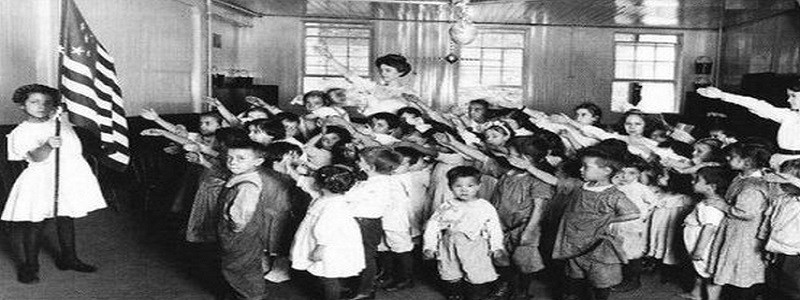
Teaching the Debate About Patriotism (Pt. 1)
By Gerald Graff
My daughter, who goes to Stuyvesant High School only blocks from the former World Trade Center, thinks we should fly an American flag our our window. Definitely not, I say” The flag stands for jingoism, vengeance, and war. She tells me I’m wrong — the flag means standing together and honoring the dead and saying no to terrorism. In a way, we’re both right.
— Katha Pollitt, “Put Out No Flags,” The Nation, October 8, 2001
What should American students learn about patriotism? First and foremost, that the concept is profoundly controversial. How controverisal, in the wake of the terrorist attacks of September 11, 2001, is suggested above in the opening of an article by Katha Pollitt that appeared in The Nation in October of that year. The passage also suggests a way of teaching contested concepts like patriotism that I have championed for some time: Teach the debate itself about such concepts, present students with opposing arguments and ask them to form their own positions.
This approach offers a democratic alternative to the usual options, in which the teacher supports either the affirmative point of view of patriotism promoted by the official culture of schooling or the skeptical critique of patriotism favored by many progressive educators. To teach the debate, instead of choosing either option, one stages a classroom controversy over patriotism, with assigned readings that exemplify clashing positions (including essays like Pollitt’s, which show that the debate may be not just between us, but inside us). Teaching such debates is not only an excellent way to promote critical thinking, but one that prevents students from feeling politically indoctrinated or browbeaten — a common danger in courses devoted to “teaching for social justice.”
To be sure, teaching for social justice usually means not indoctrinating students but provoking them to argue. “Go ahead and disagree with me,” we say to our classes. “You’ll even get a better grade if you do.” Often, however, students do not trust such assurances. By contrast, classes explicitly organized around debates on controversial issues send a more unequivocal message to students that it’s not only legitimate to disagree, but a requirement of the course.
A common criticism of teaching the debate is that it assumes a spurious neutrality. According to this criticism, teaching the debate may avoid making students feel indoctrinated, but it does so only by emptying the classroom of real political conflict and turning it into a polite debating society. But this objection misses the point. The proper antidote for the indoctrination and bullying that plague radical advocacy pedagogies is not neutrality but counter-advocacy. Indeed, a course organized around a debate between strong views and counter-views allows teachers to become more aggressive in taking sides, but with less need to worry about bullying students in the process. For in such a course, the teacher’s critical view of patriotism, say, will be resisted by strong defenses of patriotism in the course readings. Students who side with patriotic views against the teacher’s critique find their sentiments officially represented and empowered.
Teaching the debate over patirotism can be taken a step further if a second instructor is invited into the class to represent patriotic counter-views, instead of merely representing those views in the syllabus. However much we claim that we want our students to disagree with us, we can hardly expect them to do so if they never see us disagree with each other. If we are serious about the claim, we should put our money where our mouth is and open our classroom to those who are most qualified to challenge our beliefs — our colleagues. Staging periodic debates between instructors (which can be done informally, to avoid the expense and administrative complications of team-teaching) provides students with a vivid model of how to conduct intellectual disagreements that students don’t get in conventional one-teacher classrooms.
The point is that pedagogical authoritarianism may stem not only from the ideology or personal bias of the teacher, but from the very structure of the one-teacher classroom, in which teachers are sheltered from the disagreements of their colleagues. In this respect the critical pedagogies of Paolo Freire, Henry Giroux, and other liberatory educators, however transgressive the content of their message may be, are utterly conventional, since they fail to challenge the common assumption that teaching is by nature a solo performance. Though the Freirean classroom may radically question accepted political assumptions, it is thoroughly orthodox in conceiving the classroom as a closed space that protects radical instructors from being challenged by their colleagues.
The pedagogical benefits of displaccing the one-teacher classroom have been eloquently pointed out by Frank Smith in his book Joining the Literacy Club. Smith describes complaining to a colleague that his students “would never argue with me even though I gave them every opportunity. . . . My colleague told me why. They had never heard anyone argue with me. ‘Invite me to your next class,’ my friend said. ‘I’ll demonstrate how you can be argued with.'” Smith accepted the offer and
within ten minutes my friend and I had a public free-for-all, challenging each other’s logic, presuppositions, and evidence. We appealed to students to help us make each other see the light, and soon the entire class was arguing with us and with each other. Everyone was learning, including “the instructors.”
To be sure, such classroom set-tos won’t always be as smashingly successful as this one. Students can be sullen spectators instead of active participants, and probably will be if the instructors are not clear and incisive or the topic doesn’t seem pertinent to the students’ lives. But then, such alienated responses occur in one-teacher classrooms too.
This essay originally appeared in Pledging Allegiance: The Politics of Patriotism in America’s Schools, Ed. by Joel Westheimer, Columbia University Press, 2007. Part 2 will appear in The Debatifier over the coming days.

